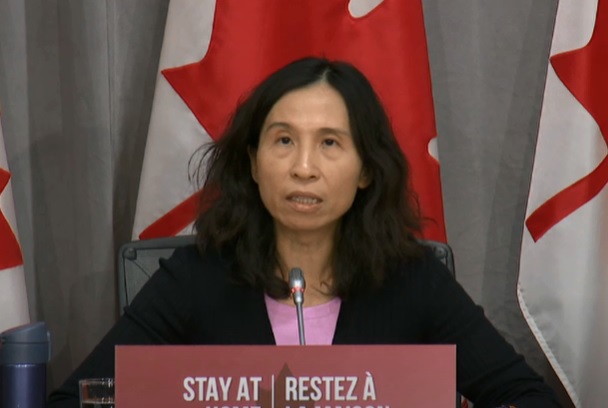In the Cabinet Committee’s daily update on COVID-19 efforts, Canada’s Chief Public Health Officer said to date 323,000 thousand tests have been done with over 4-percent positive and 95-percent testing negative for the novel coronavirus.
Dr. Theresa Tam once again addressed Health Canada’s position on face masks saying, “We are always looking at the evolving science, nevertheless it remains critical to stay home and isolate if you are showing symptoms or have recently traveled. If people stay at home, if they are sick, separating yourself is a very conclusive measure.”
Dr. Tam addressed three critical aspects of Health Canada’s advice to Canadians. First, medical masks of all kind including surgical masks, procedural face masks, and respirators must be kept for frontline healthcare workers and other providing direct care.
Second, non-medical masks like homemade masks still haven’t proven to protect the person wearing them from contracting the virus, everyone must still practice strict hygiene measures and distancing measures.
Third, wearing a homemade mask is an additional measure that Health Canada is considering for “protecting others around you as a way of you protecting others.”
She adds, “I want to make sure we have good advice around homemade masks and what materials are appropriate, so it is all under discussion right now.”
As for the procurement of more personal protective equipment for healthcare workers, Dr. Tam says, “Protecting healthcare workers is an absolute priority for the federal government and every stop is being pulled out in terms of acquiring global supplies. Not just PPE from overseas but also the domestic supply. We are also looking at other measures like how we can disinfect or decontaminate masks and how to best look at our limited supply.”
She says there is a multilayer approach to the supply of masks when there is a lot of need, “Part of it is the science of decontamination so we are looking at entities that could actually do it (decontaminate previously used medical masks) as well as asking provincial governments to instruct facilities in their regions to not throw certain items out.”
Canada’s Deputy Chief Public Health Officer Dr. Howard Njoo then said that an allocation system is in place in order to be able to send out masks when they are available according to each province.
As for testing for COVID-19 before someone shows symptoms, Dr. Tam said, “What we do know is if you put a swab in someone’s mouth and throat you can catch the virus before it is symptomatic. U.S. studies are showing up about whether presymptomatic individuals can transmit before showing symptoms. But we still believe people with symptoms are the main force in the spread of COVID-19.”
On U.S. President Donald Trump once again talking about hydroxychloroquine’s use in treating patients with COVID-19 Dr. Theresa Tam reiterated that to date, nothing has proven to work for COVID-19, “We are studying it(hydroxychloroquine), ensuring that we have it so that it is available for clinical trials and for those who may need it for other treatments. But the key message is we do know those works for other conditions and we must reserve the medication for those actual indications. It is on the list for treatments considered and studies are underway to prove its effectiveness. We have several supplies, including domestic manufacturing which ensures domestic supply is present.”
In response to a Vista Radio reporter’s question regarding whether the federal government is looking at emulating how some eastern countries are providing separate accommodations for health care workers in order to minimize the risk they pose in exposing their family or community members to the virus Dr. Tam said, “We are looking at everything to slow down the spread of COVID-19. Manitoba officials had just articulated of similar initiatives in place for health care workers who do need to self-isolate have the means necessary to do so without endangering their family members. The federal government is currently looking at all avenues to ensure that should that support be needed they can provide.”
Tam added that many healthcare workers who did contract the virus were perhaps exposed through the community and not their facility it remains the provincial and municipal medical officers who are at the best level to make decisions on their healthcare worker’s safety and others around them.
*** Story by Mo Fahim ***




